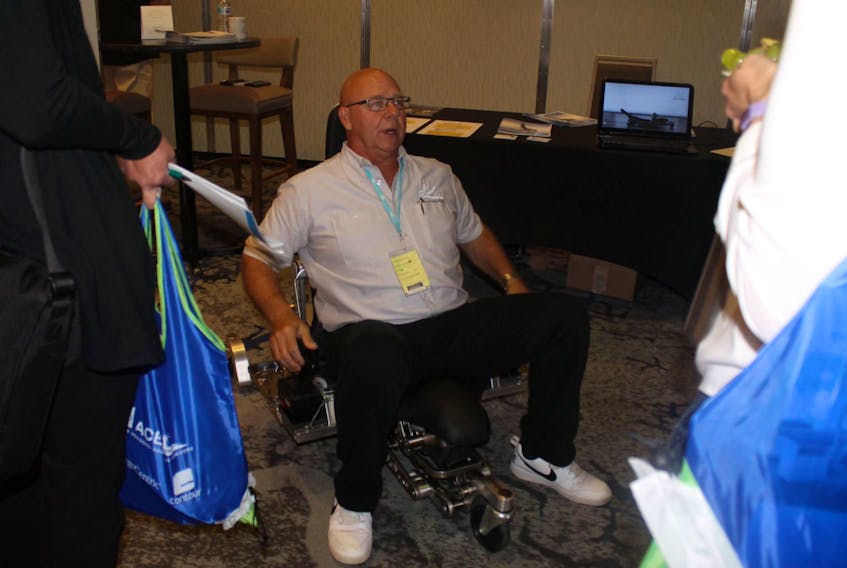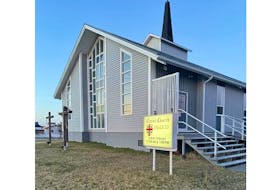ST. JOHN'S, N.L. — The Association of Canadian Ergonomists (ACE) is on a mission to reach “New Horizons,” and they came to St. John’s to take their first steps, in an ergonomically friendly way.
The 50th annual ACE conference is being held in the Delta Hotel on Gower Street this week from Aug. 12-15.
The theme recognizes the constantly changing field of ergonomics and human factors while exploring the future of work and research, and the conference is providing opportunities to learn and share with workshops, exhibitor showcases — like Human Hoist Canada — and keynote speakers, such as Memorial University alumni Catherine Courage, vice-president of product design and experience for Google.

Kathy-Lynn Shaw, organizer of the ACE conference, says St. John’s was chosen because of the challenges, and the industries and people here who need to be more open about ergonomics so they can apply it to workplaces.
“The education level here is a little different and geography is challenging,” Shaw said. “So, sometimes the opportunities for ergonomics being brought to the workplace is not always there.
Even the cost of shipping products across the island is challenging.”
But she believes more people are becoming aware of the need for ergonomically friendly workplaces.
Musculoskeletal disorder (MSDs) is one of the costliest medical conditions in Canada, with direct and indirect costs estimated to be in the $22-billion range, and musculoskeletal injuries account for almost 70 per cent of the lost-time injury claims at WorkplaceNL.
Various vendors at the conference, like Terry Cassaday of ergoCentric, have worked with ergonomists to come up with solutions to solve workplace injury problems.
“A lot of people think workplace injuries must all be in timber and fisheries, but what we are finding now is that most of them are in the offices, from people sitting doing task-related work,” Cassaday said. “It’s catching people unaware, but that is the new problem going forward, how do we deal with these issues.”

Cassaday’s business, ergoCentric, is Canada’s leading ergonomic seating manufacturer, and it was one of many businesses showcasing their ergonomic solutions at the conference.
Cassaday says a lot of companies like to outsource the choice of the chairs in their businesses to an interior design firm, which usually choose the same seat for an entire office to retain an esthetically pleasing area.
His solution to decreasing workplace injuries is offering multiple options on a task chair, such as six different seats sizes, so that a task chair can be made suitable for individual body types, while maintaining a unified office aesthetic.“You have a more diverse workforce than ever. You have older workers, you have workers with weight issues, ... people with injuries, and you need to accommodate all of your employees with the right seating solution and work station for each individual,” Cassaday said. “And a lot of employers are trying to fit everybody in one chair. Sure, it looks great, but it leaves 20 to 30 per cent of your employees being less productive. If you aren’t comfortable, you can’t be productive, and it possibly leads to MSI and injury claims. So, it’s a way of making your employees feel valued and saving money.”
Cassaday hopes the official Office Ergonomics Standards published by the Canadian Standards Association in 2017 will be a push in the right direction for business owners.
“Companies can read this document and see this is the collective expertise saying this is what an office should be, so that could be the beginning of changes and people taking it seriously.” he said.

ErgoCentric was one of many businesses in town for the ACE conference. Some new ergonomic designs were welcomed at the conference, like Human Hoist Canada and Dynamic Disk Designs Corp.'s Tritan Support Chair.
Dan Lisicky is operating solely for Human Hoist Canada — a new product to the country, but already established in the U.S. — out of Porters Lake, N.S.
“The Human Hoist is a revolutionary product,” Lisicky said. “It’s designed to ergonomically support the human body, lift and lower in a constant motion. This is for people with bad backs, bad knees, bad shoulders and even necks. With the amount of people in the workforce today, especially the aging demographic, this helps save or extend their careers.”
The chair allows an individual to go from an upright standing position to lying down through three points of contact on the chair's arms.
“The people who are using it right now, at the end of the day, they say they have more energy than they ever have.”
Jerome Fryer, a chiropractor and spine researcher, has created a chair that decompresses the spine, rather than compressing it.
One of the many features of the chair is a backrest that is located in the front, rather than on the back, like a traditional chair.
“This chair is a prototype that has been recently tested at Memorial University. Traditional chairs create compression in the spine, so this is for any office user or gamers. Anybody who sits in front of a screen would benefit from this chair.”
Fryer's goal at the conference was to find a licensing partner to collaborate and bring the chair to the masses. His son was the test subject for the chair at the conference.
“I forget I am in it. We all know it looks way different than the average chair. But I will be playing and look down and forget I am sitting in this, it’s actually so comfortable.” Fryer’s son said.
The results found by Memorial University through its testing of the chair will be presented at the ACE conference on Wednesday.
Twitter: @JasmineBurtNL









